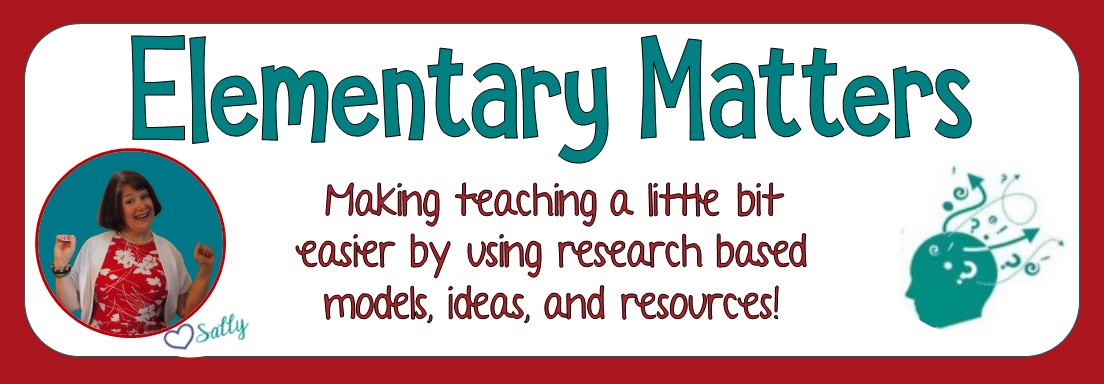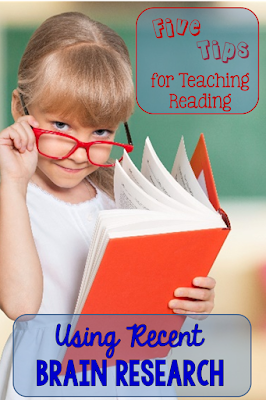fbq('track', 'ViewContent');
I've read so much about the brain based learning lately, I thought I'd share some tips that connect the two.

- Move: Kids need to move. The moving helps the brain build dendrites. Dendrites help the parts of the brain connect, which helps the memory. If the children involve moving as part of the learning, it helps the learning to stick. I find the more movement, the better. I use a lot of Brain Gym in my classroom, as well as lots of other types of movements, just to keep the dendrites flowing. Little tasks such as "take a walk around your desk", or "touch each wall" are great for the little ones. If combined with a skill ("say a short e word as you touch each wall") will help even more!

- Work together: Social Interactions are important in learning. In reading, it's important that these pairings are done at similar levels, if possible. Sometimes I let the children choose partners, but more often than not, I assign partners. (I do a lot of team building exercises the first few weeks so they are comfortable with each other, and understand their responsibilities as a partner.) Children can read in pairs, or practice spelling words in pairs, or use new vocabulary words in pairs. Sometimes I'll have the pairs teach each other something I just taught. (Teach your partner what sequencing is.)

- Coping with stress:
Teach children to deal with stress. Stress is unavoidable, it happens, even to children. But it prevents learning, so we need to help the children cope with stress in acceptable ways. I've done several yoga, guided imagery, and deep breathing exercises with the children. One of my favorites with children is The Tree. The children stand straight with their hands at their sides, and imagine they are a tree. First, the children take a deep breath in, while raising their head, imagining they are facing the sun. (I have to tell them, if I can hear the breath, it's too loud.) Their hands should stay at their sides, focusing on the sun shining on their "leaves" as they take in the sun's energies. Then they lower their heads and exhale slowly while they imagine the energy going out through their roots (toes) into the soil. A few inhales and exhales and they are good to go!

- The Arts: I've always been a fan of arts in the classroom, and the research supports this. Arts help attention span as well as working memory. I'm not just talking about visual arts (although I encourage these). Arts also includes performing arts: singing, dancing & movement, and acting. Reader's Theatre, drawing or painting pictures to reflect parts of a story, or making up a song about the setting of a story are some ways to connect the arts to reading.
- Make 'em Laugh:
Emotions play a huge role in memory, especially happy emotions. I've always been a big fan of humor in the classroom. (I doubt I would have survived this long without it!) As long as the children are happy, there's a better chance for learning to be happening. I make sure many of my Read Alouds are humorous books. There are plenty out there! Robert Munsch is a favorite of mine, as well as many children. (I LOVE The Paper Bag Princess!) Here's another list to start: funny-read-alouds .
 All in all, keep them happy, keep them busy, and keep reading to them. Reading to children is the very best way to help children learn to read.
All in all, keep them happy, keep them busy, and keep reading to them. Reading to children is the very best way to help children learn to read.

I've been a teacher for a very long time. I plan to continue teaching for a very long time. Why? Because I love it, of course! I've always felt that I was born to be a teacher. I feel so "at home" in the classroom. I enjoy interacting with children, and I enjoy watching them grow. I love reading to children, and I love listening to them read. It's a thrill when former students come back and visit. I've even had a couple of former students bring me children of their own to teach!

I love the smell of new pencils in the fall. What can be better than a box of brand new crayons, or brand new journals? I think I get even more nervous than the kids about each new year, and rarely sleep that night before the kids first come. I love when a few weeks have passed and the children are getting to know my expectations and things are settling into place.
 Teachers have been through many phases since I first started teaching in the 1970s. I remember the days of Whole Language and the days of Basal Readers, reading phonetically and reading sight words, learning centers, developmental learning, learning styles, and pretty much everything in between. And you know, it's all been good. Through each phase, I've learned more about what works in the classroom, and what works with individuals.
Teachers have been through many phases since I first started teaching in the 1970s. I remember the days of Whole Language and the days of Basal Readers, reading phonetically and reading sight words, learning centers, developmental learning, learning styles, and pretty much everything in between. And you know, it's all been good. Through each phase, I've learned more about what works in the classroom, and what works with individuals.
But I couldn't do it alone. I've been blessed with delightfully talented colleagues. I've learned lots of little tricks of the trade from each and every one of them. I'm proud of my school, as well as my district. They have managed to hire some of the best teachers I've ever seen. My district encourages teachers to try new things, and my district doesn't hesitate to find money to support materials necessary as well as training. I'm one very lucky teacher.
Probably my favorite part about being a teacher: Never does it get boring! Every day brings on new challenges and adventures. Each year brings a whole new crop of little ones with their beautiful smiling faces. What do you love about teaching?






